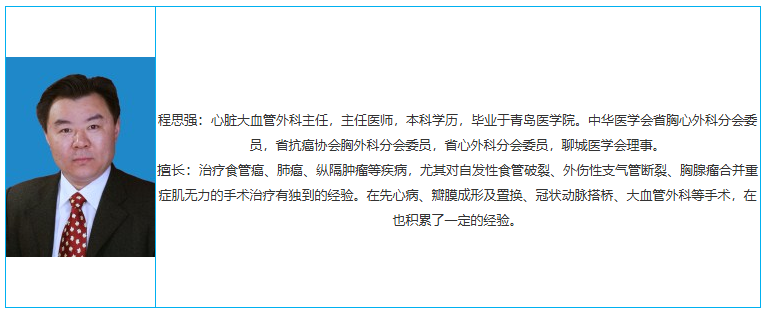- Date:2023-06-30
Introduction to Thoracic Surgery
The Department of Thoracic Surgery has 28 beds, 7 observation rooms, 7 medical staffs, including 1 chief physician, 4 deputy chief physicians, 2 senior attending physicians, 4 master's degree holders in the medical staff, and 17 nursing staffs, including 1 deputy chief nurse practitioner, 11 chief nurse practitioners, 3 nurse practitioners, and 2 nurses. Mr. Cheng Siqiang, director of the department, and Mr. Rong Lin, deputy director of the department, are standing members of the Thoracic Surgery Branch of Shandong Provincial Medical Association and the Thoracic Surgery Branch of Shandong Provincial Physicians' Association, and Mr. Rong Lin, deputy director of the department, is the deputy director of the Thoracic Surgery Branch of Liaocheng City Medical Association. The common diseases currently treated in the department include benign and malignant tumors of esophagus (esophageal cancer, esophageal smooth muscle tumor, etc.), esophagogastric junction tumors (cardia cancer), benign and malignant tumors of lungs and trachea (lung cancer, lung misshapen tumors, lung sclerosing hemangiomas, tracheal tumor, etc.), and diseases of the mediastinum and pleura (thymoma, esophageal cysts, tracheal cysts, mediastinal tumors, pleural mesothelioma, spontaneous pneumothorax, pulmonary blasts, etc.), Benign esophageal diseases (esophageal diverticulum, esophageal hiatal hernia, pancreatic achalasia, reflux esophagitis, spontaneous esophageal rupture, etc.), thoracic traumas (rib fracture, sternal fracture, lung contusion, etc.), chest wall diseases (funnel chest, chicken chest, chest wall tuberculosis, benign and malignant tumors of the chest wall, and hand sweating), and in recent years, the surgery has been based on the lumbo-laparoscopic and minimally invasive, and apart from the conventional open surgery as a basis, the minimally invasive procedures that can be independently completed now are At present, the department can independently perform minimally invasive surgeries such as thoracolaparoscopic combined esophageal cancer radical surgery, laparoscopic esophageal hiatal hernia repair, thoracoscopic lobectomy, thoracoscopic segmental lung resection, thoracoscopic lung wedge resection, thoracoscopic mediastinal tumor resection, thoracoscopic funnel chest correction, etc. The department has been in contact with the higher hospitals and has been working closely with the hospitals. The department is in close contact with higher hospitals, and has established Chen Haiquan Studio in cooperation with Fudan University Cancer Hospital, which comes to the hospital from time to time for consultation, surgery and lectures, etc. The department is well-equipped with medical equipments. The department has a complete set of medical equipments, including ventilator, multifunctional monitor, micro-pump and other equipments, which are among the highest in the whole hospital. At present, there are 3 sets of ventilators (2 sets of HAMILTON C2, 1 set of Newborn e360), 8 sets of multifunctional cardiac monitors (1 set of iMEC12, 2 sets of IPM12, 4 sets of T8, 1 set of C3), 2 sets of anti-embolism pumps (South Korea Wonjin), 1 defibrillator (M4735A), 1 set of fiberoptic bronchoscopy as well as more than 10 sets of syringe pumps and feeding pumps in normal operation.
Introduction to Cardiovascular Surgery
Liaocheng City Second People's Hospital cardiac macrovascular surgery was carried out in the 1990s, after nearly 30 years of construction and development, in 2014 in the original thoracic cardiothoracic surgery on the basis of professional subdivided from the current has become the junction of Hebei, Luzhou and Henan provinces, one of the strongest comprehensive strength of the cardiac macrovascular surgical centers, the number of open beds 20, with an annual operating volume of more than 140 units, 5 clinicians, including 1 chief physician, 2 deputy chief physicians, 2 attending physicians, 17 nursing, cardiac specialized post-operative care room, with extracorporeal circulation machine, cardiac monitor, defibrillator, blood gas analyzer, ventilator and other advanced equipment, able to independently carry out various types of cardiac disease surgical treatment, the department mainly carries out the surgical disease: coronary heart disease, rheumatic heart valve disease, degenerative heart valve disease, aortic The main surgical diseases carried out in the department are: coronary heart disease, rheumatic heart valve disease, degenerative heart valve disease, aortic coarctation, congenital heart disease (atrial septal defect, ventricular septal defect, arterial catheterization, pulmonary valve stenosis, ectopic drainage of the pulmonary veins, endocardial cushion defects, Fallot's tetralogy of Fallot and so on), hypertrophic cardiomyopathy, infective endocarditis and so on. Surgeries include stop-jump coronary artery bypass grafting, stop-jump coronary artery bypass grafting, aortic valve replacement, mitral valve replacement, mitral valvuloplasty, and open-heart repair and intervention for various types of congenital heart disease and aortic coarctation. Among them, percutaneous interventional sealing surgery for congenital heart disease, interventional aortic valve replacement (TAVR), and aortic coated stent endocavity isolation (TEVAR) have all reached the advanced level in the province. The Department of Cardiac and Major Vascular Surgery has established a good relationship with the higher hospitals, and is able to invite top domestic experts from Beijing Fu Wai Hospital, Beijing Anzhen Hospital and Shandong Provincial Hospital to consult and assist in the surgery in a short period of time.




 鲁ICP备11009722号-4
鲁ICP备11009722号-4 